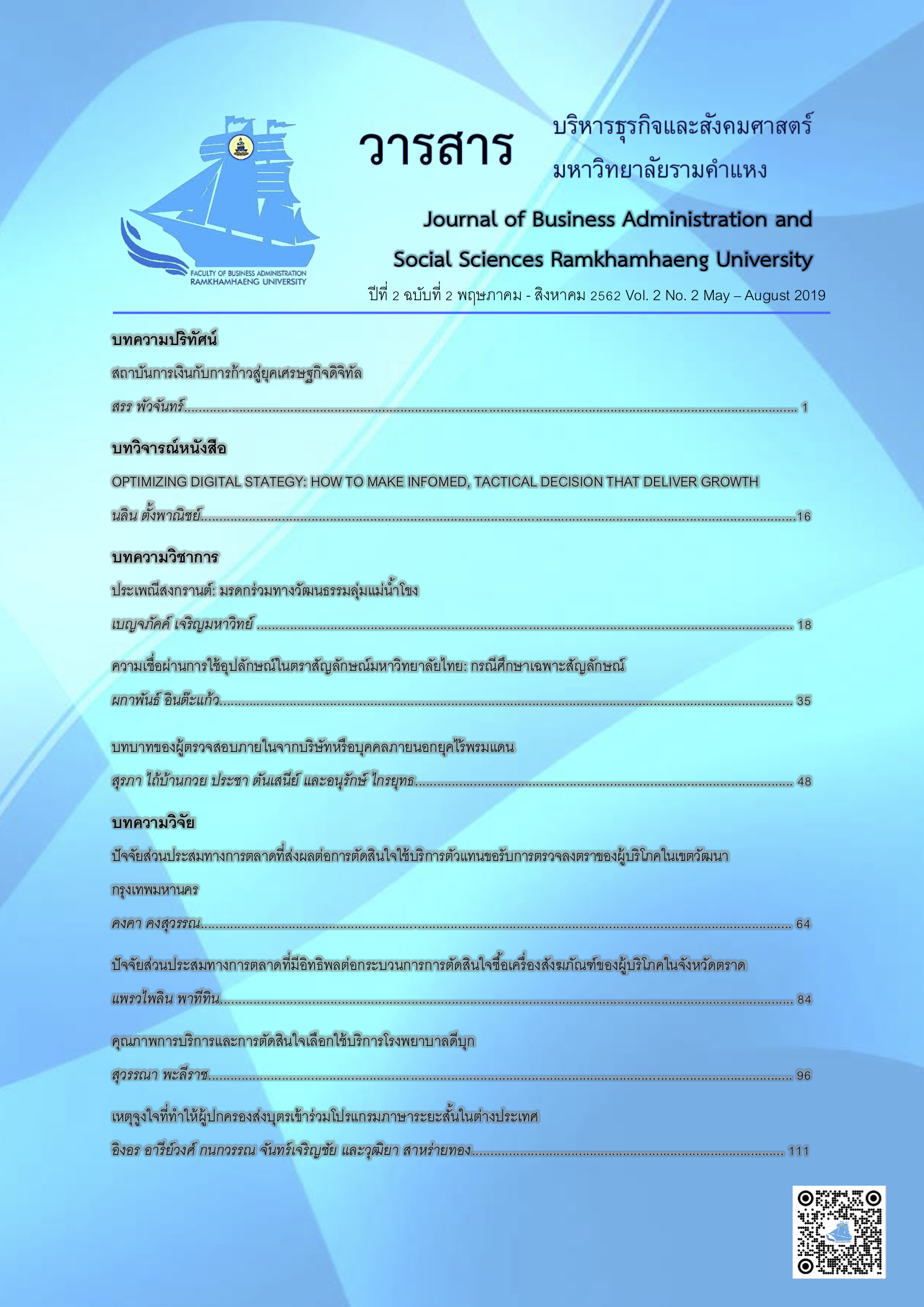ความเชื่อผ่านการใช้อุปลักษณ์ในตราสัญลักษณ์มหาวิทยาลัยไทย : กรณีศึกษาเฉพาะสัญลักษณ์
Main Article Content
บทคัดย่อ
บทความนี้มีจุดประสงค์เพื่อ 1) วิเคราะห์วิธีการนำเสนอตราสัญลักษณ์ของมหาวิทยาลัยไทยผ่านกลวิธีอุปลักษณ์ และ 2) ศึกษาความเชื่อที่ถ่ายทอดผ่านตราสัญลักษณ์ โดยคัดเลือกตราสัญลักษณ์ของมหาวิทยาลัยไทยจำนวน 9 ตราจากฐานข้อมูลสำนักงานคณะกรรมการอุดมศึกษา (สกอ.) โดยนำทฤษฎีคติวิทยามาวิเคราะห์ เพราะเชื่อว่าความสัมพันธ์ของความคิดกับชุมชนองค์กรมีผลต่อการนำเสนอสิ่งที่ต้องการถ่ายทอดออกมา ผลการศึกษาพบว่า ตราสัญลักษณ์มหาวิทยาลัยไทยผ่านการนำเสนอด้วยสัญลักษณ์ที่มีการใช้อุปลักษณ์นั้น มีการเปรียบเทียบความเชื่อกับตัวบุคคล เพราะมีพื้นฐานความคิดมาจากมนุษย์ และมนุษย์เป็นผู้มุ่งหวังความสำเร็จให้เกิดกับตนเอง ชื่อเสียง และความยิ่งใหญ่ของสถาบัน ดังความเชื่อที่ถ่ายทอดผ่านตราสัญลักษณ์ แม้จะมีสัญลักษณ์ที่แสดงอัตลักษณ์ของสถาบันตนเองที่หลากหลาย แต่มีผลกระทบต่อความเชื่อในการสร้างความเป็นน้ำหนึ่งใจเดียวกัน ความศรัทธาต่อองค์กร สร้างความภูมิใจในเกียรติภูมิสถาบัน และการแสดงตัวตนในสังคมเป็นที่ยอมรับนับถือ สอดคล้องกับแนวคิดจริยศาสตร์การศึกษาตลอดชีวิต และแนวคิดคติชนวิทยา ประยุกต์กับการสร้างภาพลักษณ์ขององค์กร
Article Details
เนื้อหาและข้อมูลในบทความที่ลงตีพิมพ์ในวารสารบริหารธุรกิจและสังคมศาสตร์ มหาวิทยาลัยรามคำแหง ถือเป็นข้อคิดเห็นและความรับผิดชอบของผู้เขียนบทความโดยตรง ซึ่งกองบรรณาธิการไม่จำเป็นต้องเห็นด้วย หรือร่วมรับผิดชอบใดๆ
บทความ ข้อมูล เนื้อหา รูปภาพ ฯลฯ ที่ได้รับการตีพิมพ์ในวารสารบริหารธุรกิจและสังคมศาสตร์ มหาวิทยาลัยรามคำแหง ถือเป็นลิขสิทธิ์ของวารสารบริหารธุรกิจและสังคมศาสตร์ มหาวิทยาลัยรามคำแหง หากบุคคลหรือหน่วยงานใดต้องการนำบทความทั้งหมดหรือส่วนหนึ่งส่วนใดไปเผยแพร่ต่อ หรือเพื่อกระทำการใดๆ จะต้องได้รับอนุญาตเป็นลายลักษณ์อักษรจากวารสารบริหารธุรกิจและสังคมศาสตร์ มหาวิทยาลัยรามคำแหง ก่อนเท่านั้น
เอกสารอ้างอิง
คณะกรรมการอุดมศึกษา, สำนักงานกระทรวงศึกษาธิการ. (2561). สถาบันอุดมศึกษาในสังกัด. สืบค้นเมื่อ 18 พฤษภาคม 2561, จาก http://www.mua.go.th/university.html.
มหาวิทยาลัยเกษตรศาสตร์. (2561). ตราสัญลักษณ์มหาวิทยาลัยเกษตรศาสตร์. สืบค้นเมื่อ 18 พฤษภาคม 2561, จาก http://www.ku.ac.th/web2012/index.php?.
มหาวิทยาลัยธรรมศาสตร์. (2561). ตราสัญลักษณ์มหาวิทยาลัยธรรมศาสตร์. สืบค้นเมื่อ 18 พฤษภาคม 2561, จาก http://www.tu.ac.th/history_tu.
มหาวิทยาลัยบูรพา. (2561). ตราสัญลักษณ์มหาวิทยาลัยบูรพา. สืบค้นเมื่อ 18 พฤษภาคม 2561, จาก http://www.buu.ac.th/aboutus/frontend/buusymbol.
มหาวิทยาลัยพะเยา. (2561). ตราสัญลักษณ์มหาวิทยาลัยพะเยา. สืบค้นเมื่อ 18 พฤษภาคม 2561, จาก http://www.up.ac.th/About_Logo.aspx.
มหาวิทยาลัยแม่ฟ้าหลวง (2561). ตราสัญลักษณ์มหาวิทยาลัยแม่ฟ้าหลวง. สืบค้นเมื่อ 18 พฤษภาคม 2561, จาก http://www.mfu.ac.th/about-mfu/introduction-mfu/about-mfu-symbol.html.
มหาวิทยาลัยวลัยลักษณ์. (2561). ตราสัญลักษณ์มหาวิทยาลัยวลัยลักษณ์. สืบค้นเมื่อ 18 พฤษภาคม 2561, จาก https://www.wu.ac.th/th/about/69/สัญลักษณ์.
มหาวิทยาลัยศรีนครินทรวิโรฒ. (2560). คู่มือนิสิตมหาวิทยาลัยศรีนครินทรวิโรฒ ปีการศึกษา 2560. สืบค้นเมื่อ 19 พฤษภาคม 2561, จาก http://sa.oop.swu.ac.th/Portals/57/ student% 20guide2017_1.pdf.
มหาวิทยาลัยศรีนครินทรวิโรฒ. (2561). ตราสัญลักษณ์มหาวิทยาลัยศรีนครินทรวิโรฒ. สืบค้นเมื่อ 18 พฤษภาคม 2561, จาก http://unity.swu.ac.th/.
มหาวิทยาลัยศิลปากร. (2559). ประกาศมหาวิทยาลัยศิลปากรเรื่อง ตราสัญลักษณ์ของมหาวิทยาลัยศิลปากร พ.ศ. 2559, ราชกิจจานุเบกษาเล่ม 133 ตอนพิเศษ 182 ง19 สิงหาคม 2559. สืบค้นเมื่อ 19 พฤษภาคม 2561, จาก 202.44.135.26/autonomy /images/ ตราสัญลักษณ์.PDF.
มหาวิทยาลัยศิลปากร. (2561). ตราสัญลักษณ์มหาวิทยาลัยศิลปากร. สืบค้นเมื่อ 18 พฤษภาคม 2561, จาก http://www.su.ac.th/th/about-about.php.
มหาวิทยาลัยสวนดุสิต. (2561). ตราสัญลักษณ์มหาวิทยาลัยสวนดุสิต. สืบค้นเมื่อ 18 พฤษภาคม 2561, จาก http://www.dusit.ac.th/university-logo-and-colors.
ศิริพร ณ ถลาง. (2559). “คติชนสร้างสรรค์” บทสังเคราะห์และทฤษฎี. กรุงเทพมหานคร: ศูนย์มานุษยวิทยาสิรินธร (องค์การมหาชน).
สำนักเลขาธิการคณะรัฐมนตรี. (2552). ประกาศสำนักนายกรัฐมนตรี เรื่อง กำหนดภาพเครื่องหมายราชการตามพระราชบัญญัติเครื่องหมายราชการ พุทธศักราช 2482 (ฉบับที่ 247), ราชกิจจานุเบกษา เล่ม 126 ตอนพิเศษ 98 ง13 กรกฎาคม 2552.
Anttonen, P. J. (2016). Tradition Through Modernity Postmodernism and the Nation-State in Folklore Scholarship. Helsinki: StudiaFennicaFolkloristica.
Bidder, C., Anabelle, K., & Saien, S. (2014). Mount Kinabalu: The sacred emblem of the first UNESCO world heritage site on Borneo. In Tourism, Leisure and Global Change, volume 1 (2014), p.TOC-1 from https://www2.nau.edu/nabejp/ojs /index.php /igutourism/article/view/331/189.
Faulds, S. S. (1994). Designing public spaces for people’s symbolic uses. In M. O. Jones (Ed.), Putting Folklore to Use. Lexington, KT: University Press of Kentucky.
Hornby, A. S. (1994). Oxford Advanced Learner’s Dictionary of current English. Bangkok: D.K. Book House.
Oring, E. E. (1986). Folk Groups and Folklore Genres: An Introduction. Logan, Utah: Utah State University Press.
Spritzer, N. R. (2008). Cultural conversation: Metaphors and methods. In R. Baron & N. Spitze (Eds.), Public Folklore. Mississippi: University Press of Mississippi.
Ungerer, F., & Schmid, H. (1996). An Introduction to Cognitive Linguistics. London and New York: Longman.


